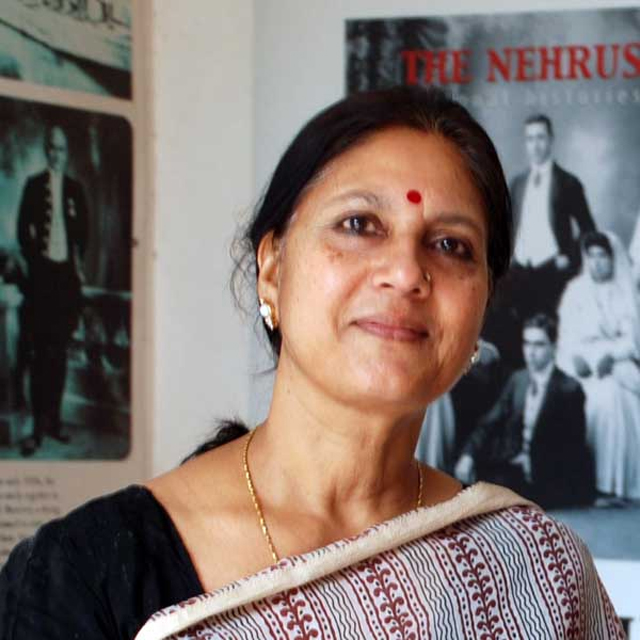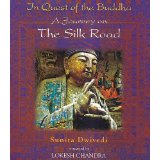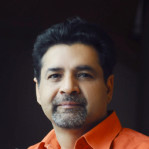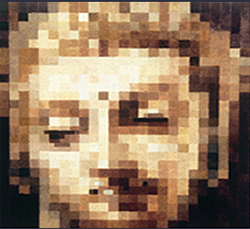
Sunita Dwivedi, famous silk road traveller, Researcher and Author Convener GACA India visited to Pakistan on invitation of GACA to further her research on Gandhara and promote Gandhara in India.
Mankiyala stupa
Takth-i-bhai Monastery
Take a rest at Jamal Ghari
Jamal Ghari main stupa
Sunita look at a place where Chinese Monk Xuan zang crossed the Indus River.
In search of Buddha: A journey of a thousand miles


I met her on the Lahore-bound bus from Islamabad earlier this month -- an educated woman about my age, medium height, clad in shalwar kurta. As we talked, I learnt that like me, she is a traveler, a writer and a journalist – but from India. It felt like a meeting of two “Dushi” (souls) — two travelers and writers pulled together with a metaphysical magnetic wave.
With three books already published, Sunita Dwivedi was visiting Pakistan, now headed to Lahore to take the bus back to Delhi after having traveled along the Grand Trunk Road with the aim of writing about the Buddhist heritage of Pakistan.
A former journalist with a post-graduate in English Literature from Lucknow University and a Masters in Education from Allahabad University, Sunita has worked with mainstream dailies like The Times of India, The Hindustan Times, and The Pioneer. She left her full time job in 1997 to pursue her passion for travelling and photography along the Silk Road through Asia and Europe. She continues to study Ancient History at Jiwaji University, Gwalior.
Sunita has travelled by road from the Wagah Border through Lahore, Gujrat, Rawalpindi, Islamabad, Peshawar and Mardan. “In no country of Asia was I welcomed with such warmth as in Pakistan, she says.
“I was here when thousands of anti-government protestors were on the streets. Tear bombs were exploding and politicians were crying hoarse. Rivers were rising and inundating thousands of villages. People around me in India were drilling fear into me. But in Islamabad, I saw that normal life was in full swing and there was no scare among the people. All was calm and quiet except in the limited area of the Red Zone near the Parliament.
“I found Lahore cleaner than Delhi and was told that streets in Lahore were washed at night. The campus of Punjab University was a canopy of flowers and amazingly clean. I traveled on the M1 and M2 Motorway and found it so grand.”
Although not a Buddhist, Sunita is known for her series of books about the impact of Buddhism in the region. The first, The Buddhist Heritage Sites of India (Rupa, 2005) with a foreword by the Dalai Lama, is an account of her own “Dharmayatra” in the footsteps of the Buddha in the land of his birth and enlightenment, from the famous rainy season retreats like Vaishali, to Himalayan and Ladakh monasteries.
The second, In Quest of the Buddha: A Journey on the Silk Road (Rupa, 2009), released simultaneously in Kathmandu and Delhi, is about her travels along the Silk Road in China and the Buddhist sites along the trade routes in the Taklamakan and the Gobi deserts, and in Sichuan and Tibet.
The just published Buddha in Central Asia: a Travelogue (Rupa, September, 2014) records her “journey into the past that still lingers on in the crumbling ruins” as she puts it. The book “describes the monastic sites of Central Asia that once reverberated with chants of monks, but are now gradually merging into dust. Soon they will become a thing of the past.”
She doesn’t recall when the Buddha first entered her life. As a child she wandered barefoot through fields and jungles to the Ramabhaar Stupa near her house in Kushinagar village, where she was born.
“I used to play at the giant mound of bricks where the Buddha was cremated two thousand years ago. The Mahaparinirvana Buddha image made a profound impression upon me. The serenity and loveliness of his face simply fascinated me.
“Can you imagine that as early as the 6th century BC, thousands of women had joined the Buddhist Sangha? They were mostly householders and lay devotees. What attracted them to the Sangha? What was it that once lured the whole of Asia to Buddhist thought? Was it not the spirit of tolerance, of peace and liberation, of the logic of the Middle Path that taught people to avoid all extremes, and of the Eight Fold Path for right behaviour? The attainment of Nirvana, the freedom from attachments is a powerful idea even for non-Buddhists. To assimilate the practice of fusion against division, of peace against violence is the need of the world. Buddhist thought transcends the barriers of cultural and ethnic differences.”
Since the time of Asoka the Great in the third century BC, scholars and translators of Buddhist texts, monks and pilgrims, travelled with trade caravans along the ancient Silk Routes to spread the message of the Buddha, building stupas and monasteries along the way. The remains of these “crumbling monasteries that seemed unable to fight the forces of nature” are still visible, says Sumita, who has traveled from Kabul in Afghanistan to Kayalik in Kazakhstan through Tajikistan, Turkmenistan, Uzbekistan and Kyrgyzstan. “They exist precariously on mountain tops, in the Gobi and Taklamakan deserts, along rivers and in the steppe lands of Central Asia.”
What does she think about Central Asia as a tourism destination?
“Many places in Central Asia are hot tourist spots,” she responds. “The Paghman Darreh and Bagh-e-Babur of Kabul, the painted caves of Bamiyan, the marble city of Ashgabat, Dushanbe where the National Museum of Antiquities houses the largest Buddha of Central Asia, the medieval monuments of Bukhara and Samarkand, the historical museums of Bishkek, the nature reserves of Almaty and the Buddhist sites of Xinjiang are all top tourist destinations. But it is difficult to get a visa to visit Central Asia although most have contiguous borders with Pakistan and India.”
What does she think of Central Asian hospitality?
“Central Asia is a lovely place to be in. Even though you may not know Russian or local languages you will still understand what people are saying. There is a special bond between Pakistan, India and Central Asia historically and culturally. As soon as you say you are from India or Pakistan people flock around you. They are extremely welcoming. Even if you enter a shop and buy nothing you are greeted with freshly cut melons, bunches of black and green grapes, dry fruits and black tea. All this for free.”
She found herself fascinated by many places – “the ancient caravan serais and bazaars of Bamiyan, old Bukhara and the Registan of Samarkand, the Blue city of Mazar-i-Sharif, Bishkek - the Switzerland of Central Asia and of course the hills and nature reserves near Almaty."
Any incident that stands out in her mind is having to wear a burqa over her shalwar kameez. Traveling from Kabul to Mazar-i-Sharif with her friend Fauzia Wardak, she says, “We knew we would have to trudge into the remote villages of the northern province of Afghanistan where one has to observe the local tradition of purdah. So Fauzia and I clad in long burqas over our salwar kameez and heads covered in black scarf scurried in and out of Aibak where I was in search of the Naubahar monastery. That was the first time in my life, I wore the burqa and covered my face even as I walked along the pradikshana path at Takht-e–Rustam.”
Ideally, where would she like to spend the most time?
“I could live all my life in Samarkand, the beautiful city of Timur and spend hours gazing at the architectural wonders of Sher Dor and Ulughbeg Medrassas and the brilliance of the Tillakari mosque at the Registan Square.
“I would love to spend more time in the Archaeological Park of ancient Merv in Turkmenistan which is dotted with dozens of ancient and medieval settlements. Here one can find camels with decorated tents on their back to take tourists from one settlement to another inside the desert. Also I dream of another, perhaps a last chance to search for the Buddhist monastery of Gyaur Kala that I could not locate inside the deserts of Merv.”
I asked if she had seen Muslim cultural heritage and monuments in Central Asia also?
“I saw more Islamic monuments than Buddhist,” she replies. “Many times I prayed at the mausoleums of Sufi saints and in mosques, like the Blue Mosque in Mazar-i-Sharif, the Ruhi Masjidi near Ashgabat, the Kalon Mosque in Old Bukhara, Juma Masjid at Ichon Kala in Khiva, Khoja Akhmed Yassavi’s mausoleum at Turkistan which is also called the second Mecca for Muslims, Arslan Bab mausoleum at Otrar, the Dungan Mosque at Zharkent…
“The medieval Muslim monuments of Central Asia with their splendid calligraphic art, amazing inlay work and architecture are a source of great pleasure. I also happened to see the holy 7th century AD Othman Koran at the Khast Imam Square in Old Tashkent, and countless other Islamic monuments whose spiritual magnetism is irresistible.”
A final word from this intrepid traveler and scholar: “The need of the hour is to propagate peace and prosperity by preserving our common cultural heritage and to develop our societies peacefully. This will go a long way in focusing on education, health and infrastructure development. Today, the ‘Middle Path’ of Buddhism is even more relevant to avoid the path of extremism for resolving issues — internal or external.”
 By Agha Iqrar Haroon
By Agha Iqrar Haroon
Sunita Dwivedi is a traveler, a writer and a journalist. I met her in a bus while travelling to Lahore from Islamabad. She was going to Lahore to take her bus for Delhi. We never met before and we never knew each other but as a traveler, writer and a journalist myself—something inside me lured me to talk to her and Yes it was a meeting of “two Dushi” (две души) —A meeting where souls of two travelers and writers pull through a metaphysical magnetic wave.
Sunita Dwivedi is a successful writer and her book “The Buddhist Heritage Sites of India” published in 2005 had a foreword by The Dalai Lama. Its Russian translation was released in Moscow by Ocean of Wisdom Publications in 2012. The next one on Buddha along the Chinese Silk Road was published in 2009 and released simultaneously in Kathmandu and Delhi. The third one Buddha in Central Asia has been published recently in September, 2014 and is on the stands. Sunita is not a Buddhist. She happens to love the Buddha.
Her first book takes the reader through the better known sites of Uttar Pradesh, Bihar, Sikkim, Arunachal Pradesh, Ladakh, Himachal Pradesh and even across the borders to Nepal – covering the entire Dhamayatra of the Buddhist circuit.
She has been travelling all over South Asia and Central Asia to document archeological spots related with Buddhist history. She is moved with hospitality of Central Asia and spellbinds with beauty and grandeur of Samarkand—the Jewel of Central Asia. She wishes to spend her whole life in Samarkand commenting as:
"I could live all my life in Samarkand, the beautiful city of Timur and spend hours gazing at the architectural wonders of Sher Dor and Ulughbeg Medrassas and the brilliance of the Tillakari mosque at the Registan Square"
http://www.thenews.com.pk/Todays-News-14-274520-In-search-of-Buddha-A-journey-of-a-thousand-miles
 Home | About Us | Gandhara Renaissance | Venerable Monk Speech | Events & Activities | Contact Us
Home | About Us | Gandhara Renaissance | Venerable Monk Speech | Events & Activities | Contact Uswww.gandharaartandculture.org © All Rights Reserved 1998-2025


